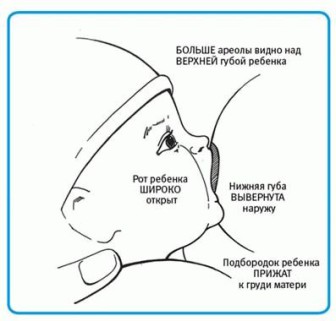
1. When to start breastfeeding a newborn?
Inexperienced mothers are often worried if the feeding schedule goes awry. This excitement can negatively affect the formation of lactation. Even experts now refuse conservative recommendations and are inclined towards a more flexible approach, because all the kids are individual. According to experts, each mother with a child should find the moment when it is better to start feeding.
To stimulate sucking, the baby is usually applied to the breast immediately after birth. This technique is called “climbing to the chest”: the baby seems to crawl along his mother’s belly and naturally finds the nipple. Even if a woman has had a cesarean section, you can still put crumbs on her belly. While the operation will continue, the first tactile contact will occur in the mother and child. If a woman was injected with a painkiller during natural birth, and the baby was born slightly sleepy, doctors will help him to take the right position.

It is best for the first time to breastfeed the baby during the first hour after he was born. The proximity of mother and child is necessary to stimulate the synthesis of oxytocin, a hormone that promotes the production of milk at the very beginning of lactation, reduces stress in a woman and helps to establish a connection with the baby.
According to the observations of foreign pediatricians, mothers who put babies to their breasts immediately after birth already kiss three-month-old babies more often than those who are not allowed to do this. By the time their children turn 1 year old, they are already establishing and maintaining a closer physical relationship with infants and have continued to breastfeed for longer.
We also read: What is the importance of putting a newborn to the breast early (applying immediately after birth)
2. How to apply the baby to the chest?
The newborn should be placed close to the chest. He should touch the bottom of his chin, but still be able to open his mouth so wide as to grasp the nipple with the areola. If the baby touches the bottom of the nipple with the lower lip, carefully remove it from the chest, tilt the head back and attach again. This is the best position for feeding, in which the woman does not feel pain.
After feeding, when the baby is "removed" from the chest, the nipple is elongated, but it should not look crushed or flattened.

If the mother does everything right, she does not feel discomfort during feeding. The exception is only the beginning of the first few feedings, when the nipples adapt to natural stretching.
We also read: How to breastfeed: how to properly apply a newborn baby to the breast
3. How to understand that milk is enough?
You will understand this by increasing the weight of the baby and the contents of the diapers. Do not worry about how long the baby sleeps, how long the intervals between feedings last. Weight gain and the contents of diapers will tell you everything. It is also important to note that 5 days after the appearance of the crumbs in the light, his urine should become mustard yellow. For 10-14 days, babies regain the weight that was at birth.

4. How long should each feeding last?
On average, a newborn eats from 10 to 40 minutes, but all babies have their own characteristics. Some eat longer in time, this is also normal, others are much faster if they suckle well, and mom has a lot of milk. However, evening feeds usually last longer than the rest.

If the baby falls asleep on his chest after a few minutes, you can feed him a little more. There are babies who stay for a long time at the breast and suck it just to calm down.
5. How to understand that there is little milk, and what to do in this case?
Only 5% of all nursing mothers are deficient in breast milk. The causes may be a malfunction of the thyroid gland and hormonal failure. Sometimes little milk is produced due to insufficient development of breast tissue.
It is important to understand that milk does not end just like that. It will be produced in such quantities as are necessary for the baby. Therefore feed the baby as much as he asks. If you see that there is a problem, begin to control how the child is gaining weight. Weigh it before and after feeding.
It is also worth checking how the baby takes his chest - perhaps he is doing it wrong. A breastfeeding consultant or pediatrician can also help.
We also read: If there is not enough breast milk, what should I do? My advice
6. Do I need to feed only one breast or then give a second?
It is convenient for some mothers to give the baby one breast in one feeding, and another in another. Others prefer to offer both during each feeding.
Gradually, milk becomes fatter. If the baby eats from one breast and is full, there is no need to offer him a second. It’s more important to just follow the baby. If the baby begins to worry and come off, gently remove the chest and offer a second. The child himself will let you know when he is finished eating.
7. Can mastitis develop?
Even before mastitis warning signs appear that help prevent the disease. If the milk is not completely removed from the breast, the ducts may have clogged. In this case, the chest will become heavy, clots will appear in it, it will be much warmer to the touch than usual.
To stimulate the elimination of excess milk and establish normal lactation, do massages, breast-feed regularly and use a breast pump.
If mastitis has already developed, it can be suspected by red spots on the skin, swollen and very painful breasts.

In severe cases, doctors prescribe antibiotics to women. However, to establish lactation and feed the baby is still not as difficult as it might seem at first.
8. To what age do you need to breast-feed a baby?
On the recommendation of the World Health Organization (WHO), breast-feed recommends up to 6 months. You can then introduce proper complementary foods, combining it with breastfeeding for up to 2 years or longer.
Recommended publications on breastfeeding:
Breastfeeding: video instruction, advice of doctors
Video instruction for mothers on breastfeeding: how to prepare for feeding, what difficulties and problems there may be during breastfeeding, how to properly apply the baby to the breast.










Mastitis was often tormented with the first child, with the second she was more attentive, made sure that there was no lump, massaged her chest so as not to bring to temperature and terrible pains.
At first, breastfeeding is hard and painful, but gradually you get used to it. And for the baby there is nothing more useful than mother's milk. I generally breast-fed my son until he was 2 years old, barely weaned. He was born with a moderate state, but now he is a healthy girl.
I'm getting ready to become a mom and study the issue. Of course, there are so many nuances in breastfeeding that it’s hard not to worry. And fears, such as milk, are not enough - they have already begun to visit me. I will try to do everything as correctly as possible.
I never fed the child according to the schedule, as she wants to eat, she gave me breasts. The baby ate quickly, the milk was oily. After feeding, it was necessary to decant the residues. Well, of course I tried not to be nervous, I was completely all in the kid. Proper nutrition has eliminated some foods from your diet. I breast-fed a year.
Redness and mastitis as a result often occurred with the first child.
Folk remedies have become the best medicine for me: mashed warm cabbage leaf and honey cake, the safest and most effective medicines in the Guards.